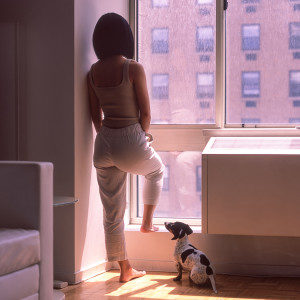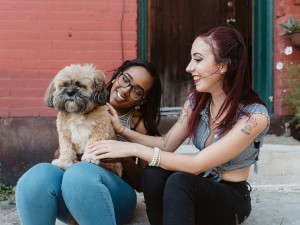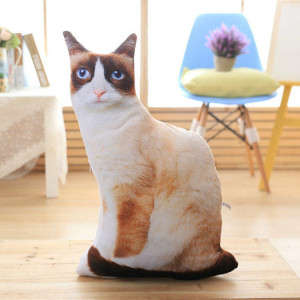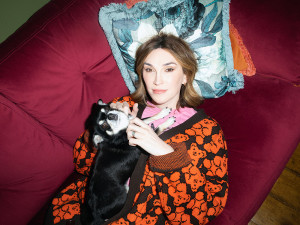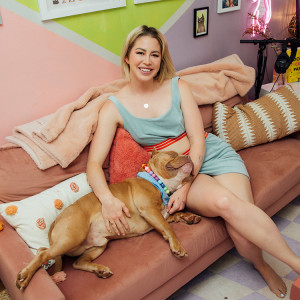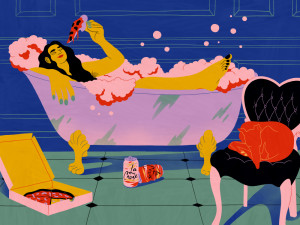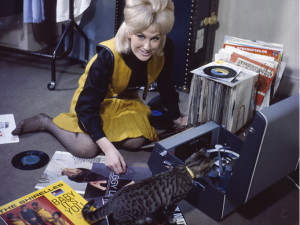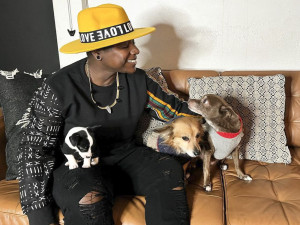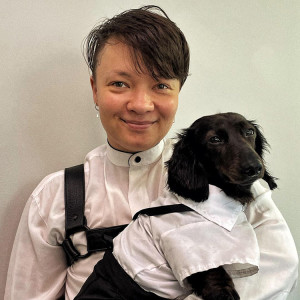How I Built My Queer Family One Pet at a Time
My life looks nothing like I imagined growing up—but it’s perfectly complete.

Share Article
Every family looks a little different. Queer families especially. Queer people tend to come from “traditional” family structures that have failed us in some way: parents who stayed together when they shouldn’t have, parents who weren’t really ready to be parents, parents who didn’t stay together. Yet regardless of the family structures we’ve experienced, we all still have a deep longing for family, for community and love. It just may not look like a man and a woman with a couple of kids. It may look like something else entirely. Or almost that but… not quite. A structure all its own.
I was born to a Southern Baptist minister and a stay-at-home mom. My mother never finished college, only worked part-time, if at all, as I grew up, but both my parents wanted me to go to college, and perhaps more importantly in their minds, wanted me to marry a nice Christian boy and give them grandkids. And for a long time, that’s what I thought I wanted, too. I started feeling attracted to boys in middle school, so I never wondered if I was also attracted to girls. I met the required qualification for being a straight girl: I liked boys. All I had to do was find the right one, and the rest of my life would fall neatly into place.

Get (totally free) deals for food, treats, accessories, tech, and way more pet parenting must-haves.
opens in a new tabBut right before seventh grade, we moved to a new town, and I struggled to make friends. I grew lonely and bitter about my loneliness, and spent most of my time outside school in my room reading or watching TV and always writing something. Usually, melodramatic poetry about how no one understood me.
My early connection with pets
The one constant in my life was my childhood dog, Aslan (yes, named after the Jesus-lion in The Chronicles of Narnia; did I mention I grew up Christian?), affectionately known as Azzy. As I passed through my entire adolescence without going on a date, being kissed, or even holding hands with a potential partner, I had a hard time imagining a future life where I was in love and married. Instead, I started imagining a life where I lived alone with a dog. I knew Azzy wouldn’t be around far into my adulthood, but I planned to adopt a Standard Poodleopens in a new tab, and we would live together in a house with a massive library, just the two of us against the world. Who needs romantic love when you have a dog?
Then, when I was 21, I met a nice Christian boy and fell hard. He had aspirations of being a youth minister (just like my father had been, which gave me a bit of an anxiety attack), and he confessed to me early in our relationship that he “struggled with same-sex attraction.” For those who weren’t religiously traumatized, that’s Christian-speak for “I’m queer, but my beliefs won’t let me accept who I am.”
By that point, I was fully an LGBTQ+ ally. My best friend had come out to me, and I had known several queer people in high school and college. I told my boyfriend that there wasn’t anything wrong with his feelings, and of course he didn’t believe me, though he appreciated my acceptance. I knew then that he was bisexual, but I didn’t know if he would ever come around to that conclusion himself. But we kept dating, and three years later, we were married in the church my father pastored. A good, Christian couple starting their good, Christian lives.
Confronting change — and heartbreak
Things changed slowly. My husband, who started out as a part-time youth minister, left the church when I accepted a job in another city. We agreed to find a new church in our new town, but he was so burnt-out from working in the ministry that we rarely attended on Sundays. With that distance from the world we’d both grown up in, we had time to actually grow as people. My husband finally came out to me as bisexual, and we both drifted farther from our Christian beliefs.
By 2018, we had moved from Missouri to Maryland and all but given up our faith entirely. We adopted a second dog, Lilo, a medium-sized mix that looks like a cross between a German Shepherd and a Corgi, mostly to keep Nani, our social Lab / Great Pyrenees mix, company. With two dogs and our first house, we started building a family of our own. In 2019, we decided to have a baby. I got pregnant quickly, and we made plans for a nursery in our new home and for how we’d announce our new addition and introduce our two dogsopens in a new tab to their human sibling.
Then, of course, the pandemic happened in early 2020, which in many ways for us felt secondary to the 20-week appointment where we found out our baby would not survive. We chose together that an abortion would be the best option for my mental health and to start healing from our loss as soon as possible. It was hard to tell our families, especially our parents, who claimed their support but didn’t take the news of our decision all that well. Because of lockdown, it was easy to retreat.
We didn’t see anyone, didn’t leave the house, and found all the solace we could in our pets. My camera roll from those months features almost no photos of either of us and dozens of photos of our dogs. That wasn’t so different from most days, but it was a marker then of how I didn’t want to see myself, didn’t want to face how much I’d lost — and how much I had changed.
Moving forward
I wasn’t unique in having a lot to deal with in 2020, but the feelings that accompanied my grief took the forefront. Part of me was relieved at not having to change my life for a child, and that was my first inkling that I didn’t really want to be a parent. As much as I claimed to have moved beyond my Christian upbringing, its ideas were still deeply embedded in my head: a persistent, nagging voice at the back of my mind. I had just always assumed I would be a mother, and now that I wasn’t, there was a void where my idea of self was supposed to be. I felt like I was starting from scratch, figuring out who I was and who I wanted to become at 30 years old.
There wasn’t a specific moment when I came out as bisexual. It was more a slow-dawning realization that I felt I should’ve had years before. When I finally came out to my husband, he was as unsurprised as I’d been when he came out to me, and accepting my queerness felt, more than anything, like pieces falling into place. My marriage had never really felt like the straight marriages I’d seen around me, and redefining my relationship as queer just made sense.
The one thing that didn’t change was my devotion to my pets. A year after losing our child, my husband and I decided to adopt a kitten. We found Goose (formerly Pancake) at a local shelter and fell in love with his cream-colored fur and white “socks” on all four feet. With his sweet yet obnoxious personality and very vocal nature, Goose felt like the missing piece to our little family, the one thing we needed to feel, finally, complete.
Goose got along with our dogs instantly, becoming our youngest dog’s best friend and favorite playmate. For me, parenthood became about being a pet mom, spoiling our dogs with unnecessary toys, buying a giant cat tower and scattering scratching posts around the house. And this year, we became parents again to a Miniature Australian Shepherd named Rogue, who is Goose’s instant best friend.
As a teenager, I’d imagined my future as just me and a dog, so I always knew that my family structure may not look like what I’d been told it should. What I couldn’t imagine was what else my life would include: a loving partner, a career as a writer, and the confidence and joy that comes with truly knowing who you are. My family is perfect because it’s perfectly mine. And while I’m sure its makeup will change over the years, the beautiful thing about queerness is the way we can make a family out of any pieces.
There are no rules about what constitutes a family, whether it’s one person or two or several, your actual relatives or the friends who are closer than blood, your kids or your pets or both. Queer family is what we make it, and in the freedom to build our own families, we are also free to be truly ourselves — genuine, messy, grieving, healing, rebuilding, and always full of love.

Savannah Admire
Savannah Admire is a writer, poet, and pet mom to three dogs and a cat. She currently lives in Western Maryland. When she’s not writing, you can find her reading, taking photos, or volunteering as a content creator for her local community theatre. Her debut poetry book, Mother Viper, is due out August 12, 2025, and you can follow her on Instagram at @savannahcooperpoetopens in a new tab.
Related articles
![Juno Dawson on a couch with her Chihuahua, Prince]() opens in a new tab
opens in a new tabJuno Dawson and Her Dog Prince Think You Need to Chill
The author of the ninth-most banned book in the US finds joy in creating queer art and basking in the unconditional love of her Chihuahua.
![Kelsey Darragh with her dog Hippo]() opens in a new tab
opens in a new tabKelsey Darragh’s Pit Bull, Hippo, Is Her True Soulmate
The filmmaker, comedian, and mental health advocate’s boyfriend didn’t want to adopt their foster pup. She ditched the guy and kept the dog.
![painting of a women in the bath]() opens in a new tab
opens in a new tabSofie Birkin’s Art Is Feminist, Fantastical, and Fiercely Queer
“I think the relationship between a woman and her animal companion can build out a character a lot — they’re more like witches’ familiars than pets.”
![]() opens in a new tab
opens in a new tabTegan Quin’s Dog Is Behind Some of Her Deepest Feelings in Her New Music
The songwriter has her pup, Georgia, to thank for her new depths of vulnerability on Crybaby, Tegan and Sara’s new album.
![Dusty Springfield sitting on the floor with a record player and a cat]() opens in a new tab
opens in a new tabMust Read: Queer Icons and Their Cats
Striking photographs and captivating anecdotes about LGBTQ+ trailblazers and their feline friends, from Freddie Mercury and Janis Joplin to Alison Bechdel and Tig Notaro.
![Stoney Michelli Love with her two dogs]() opens in a new tab
opens in a new tabStuzo Founder Stoney Michelli Love Is “Coming for the Crown” With a New Dog Fashion Line
Fashion without the constraints of gender? Paws up for that!
![person and their dog]() opens in a new tab
opens in a new tabAutomic Gold’s Muse and Model Is a Design-Savvy Dachschund
Founder Al Sandimirova on launching a body-positive brand, designing sustainable jewelry, and laboring under Luna’s watchful eye.
![African American woman with floral arm tattoos and short curly hair laughing with joy while holding her small Chihuahua dog outside]() opens in a new tab
opens in a new tabForget Goat Yoga. Jessamyn Stanley Practices With Her Pets
Turn those barks and meows into namastes.
